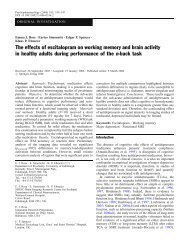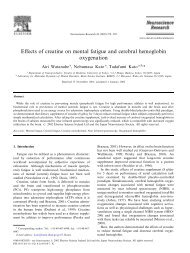Transcranial Direct Current Stimulation during Sleep Improves ...
Transcranial Direct Current Stimulation during Sleep Improves ...
Transcranial Direct Current Stimulation during Sleep Improves ...
You also want an ePaper? Increase the reach of your titles
YUMPU automatically turns print PDFs into web optimized ePapers that Google loves.
Marshall et al. • tDCS on Memory <strong>during</strong> <strong>Sleep</strong> J. Neurosci., November 3, 2004 • 24(44):9985–9992 • 9987figures and their hand movements were visible to them only through amirror. Two different sets with seven different figures were used. One setconsisted of a line-drawn five-pointed star, for practice, and six linedrawnhuman figures made up of 26–28 segments joined by 25–27 angles.In the second set, the straight segments were curved. The apparatuswas as described in detail by Plihal and Born (1997). Performance wasassessed by a light sensor of a tracing stylus that indicated whenever thestylus left the line to be traced. Subjects traced the figures with a stylusstarting and ending at the same point. An error consisted of moving thestylus off the line of the figure. Subjects first practiced with the star untila maximum of only six errors was made and continued with the linefigures. In the recall condition, subjects traced the same figures, startingwith the star to warm up. Performance measures were mean draw timeand mean error count, collapsed across the six line-drawn figures.d2-test, PANAS, EWL. On the d2-test of attention (Brickenkamp andZillmer, 2002), subjects are required to cross out specifically markedtarget letters in several sequels of signs. Total count of signs processedwithin 45 sec, and errors were calculated as an estimate of the capabilityto concentrate. The PANAS describes, by a five-point self rating, thesubject’s current mood on two dimensions: positive (enthusiastic, active,and attentive) and negative (irritability, nervousness, and fear) affect(Watson et al., 1998). The EWL (Janke and Debus, 1978) is an adjectivechecklist describing the subject’s mood on 15 dimensions (e.g., activated,tired, high spirits, irritable, excited, fearful).Polysomnographic and EEG recordings and analysesEEG (Fz, Cz, Pz, Oz, C3, C4, P3, P4, F7, F8, T3, T4, T5, T6) and verticaland horizontal electro-oculograms were recorded continuously by aDC/AC amplifier (Toennies DC/AC amplifier; amplification, 200 V/V;1–35 Hz; Jaeger GmbH and Co. KG, Würzburg, Germany). Analog DCEEG signals were digitized at 200 Hz per channel (CED 1401; CambridgeElectronics, Cambridge, UK).Three types of comparisons were performed between the conditions oftDCS and placebo control. First, sleep structure was compared betweenthe sessions based on standard polysomnographic criteria (Rechtschaffenand Kales, 1968). For the total sleep epoch as well as for a 45min interval beginning with the onset of tDCS (i.e., the first appearanceof SWS), every 30 sec epoch was scored as NonREM sleep stage 1, 2, 3, 4,or REM sleep. SWS was determined as the sum of sleep stages 3 and 4. Forthe placebo condition, sleep stages were determined for correspondingintervals. The time in minutes for each sleep stage, the total sleep time,and the percentage of sleep time in each stage with reference to total sleeptime were determined. Mean time spent in the different stages beginningwith the onset of stimulation and ending 15 min after termination of thestimulation interval was calculated and compared with respective intervalsof the control session. In a second analysis, average EEG power wascompared for the 30 min interval of DC stimulation and the correspondinginterval <strong>during</strong> the placebo condition for the following bands: (4–8Hz), 1 (8–10 Hz), 2 (10–12 Hz), spindle frequency (12–15 Hz), 1(15–20 Hz), and 2 (20–25 Hz). This analysis was run separately forperiods of SWS and stage 2 sleep. A third analysis concentrated on theimmediate effects of DC polarization. For this purpose, average powerspectra for all the above frequency bands were compared <strong>during</strong> the 60 15sec intervals of acute cortical polarization with that obtained for the 60intermittent 15 sec breaks in which the DC stimulation was discontinued.The time course of short-term effects across the 15 sec epochs wasalso assessed. As a result of on–off artifacts in the EEG induced by thestimulation, 13 sec rather than 15 sec intervals were analyzed. Powerspectra and corresponding bands were calculated using three overlappingor for time course analyses moving windows of 5 sec intervals (2048data points), resulting in a resolution of 0.098 Hz per bin. Only artifactfreeintervals were used. A five-point moving average was applied to theindividual data before averaging.HormonesFor blood sampling, a catheter was connected to a long, thin tube enablingblood collection from an adjacent room without disturbing thesubject. Standard HPLC with electrochemical detection was used forplasma norepinephrine detection [sensitivity, 35.64 pmol/l; interassaycoefficients of variation (CV), 6.1%]. Assays used for determination ofcortisol and growth hormone were an ES300 (sensitivity, 1.0 g/dl; intraassayCV, 6%; interassay CV, 4%; Boeringer Mannheim, Mannheim,Germany) and a RIA (sensitivity, 0.9 g/l; intraassay CV, 5%;interassay CV, 9%; Diagnostic Products Corporation, Bad Nauheim,Germany), respectively.Statistical analysesStatistical analyses relied in general on ANOVA with <strong>Stimulation</strong> (tDCS,placebo) as repeated-measures factor and mental state (<strong>Sleep</strong>, Wake) asgroup factor. When appropriate, a Greenhouse–Geisser correction fordegrees of freedom was used. A p value 0.05 was considered significant.Paired t tests were used for comparisons of time courses.ResultsMemory tasks and psychometric testsOn the PAL task, learning before sleep (<strong>Sleep</strong> experiment) andwakefulness (Wake experiment) was comparable for all conditions.The number of trials required until the criteria of 60%correct responses was obtained at immediate recall in the <strong>Sleep</strong>experiment was 1.37 0.09 and 1.33 0.09 for tDCS and placeboconditions, respectively. In the Wake experiment, 1.50 0.15 and 1.42 0.15 trials were needed to reach the learningcriteria ( p 0.6, for respective differences between stimulationconditions). The number of words recalled at the criterion trial<strong>during</strong> learning (shown in Table 1) also did not differ amongconditions ( p 0.2, for all comparisons). For assessing effects oftDCS on subsequent memory formation, recall performance afterthe retention trials was compared with the individual performanceat learning before (Fig. 2, Table 1). In the <strong>Sleep</strong> experiments,recall generally improved across the sleep retentioninterval, and this improvement was distinctly greater when tDCSwas applied than placebo stimulation (F (1,17) 10.44; p 0.005).In the Wake experiments, recall performance on average did notimprove but slightly decreased across the wake retention interval(F (1,28) 4.81; p 0.05, for the difference between <strong>Sleep</strong> andWake experiments). Moreover, there was no effect of tDCS onretention performance in the Wake experiment (F (1,11) 0.04;p 0.8) (Table 1).Table 1 also summarizes results of draw time and error counton the mirror tracing task. Performance at learning before theretention intervals was comparable between tDCS and placeboconditions of both experiments ( p 0.5), although subjects ofthe Wake experiment made more errors than subjects of the <strong>Sleep</strong>experiments (F (1,28) 7.48; p 0.01). Compared with placebo,tDCS did not affect memory for mirror tracing, as assessed by theimprovements in speed and accuracy at recall, neither in the <strong>Sleep</strong>experiments ( p 0.5 and p 0.8 for speed and accuracy, respectively)nor in the Wake experiments ( p 0.3 and p 0.5, respectively).Subjects of the Wake experiments showed a greaterreduction in error count across the retention interval than thoseof the <strong>Sleep</strong> experiments (F (1,28) 7.51; p 0.01), which mightbe a result of the generally higher error rate at learning in thesesubjects.The d2 attention test did not indicate differences in concentrationbetween tDCS and placebo conditions neither at learningbefore sleep (total count of processed signs, 511 11 vs 513 14;error count, 18 4 vs 18 4) nor at recall after sleep (total countof processed signs, 531 9 vs 516 12; error count, 15 3 vs16 4; p 0.2). There were also no differences in d2 performanceat learning and recall testing in the Wake experiments( p 0.3).The PANAS questionnaire indicated that positive affect decreasedgenerally across the retention interval. However, <strong>during</strong>




